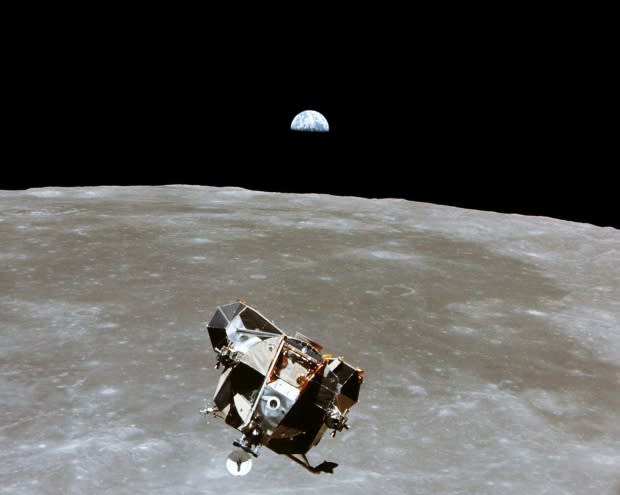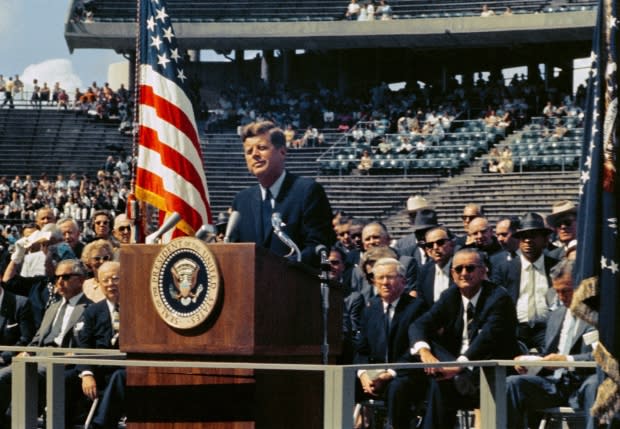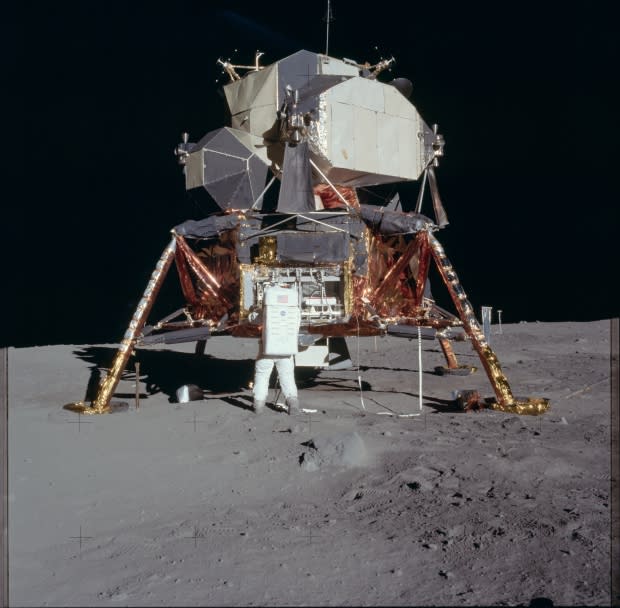Looking back to Apollo 11: How we did so much with so little
This story is part of Moon Landing: 50th Anniversary, a series from CBC News examining how far we've come since the first humans landed on the moon.
It had about 1.5 per cent of the computing power in a cellphone, but the giant Saturn V — still the world's most powerful rocket — was mighty enough to usher in the dawn of a new space age.
On July 20, the world will mark the 50th anniversary of humans' first steps on the moon. But few likely realize just how much ingenuity was required for that historic trip.
Today, scientists working on rockets have the advantage of having had most of the groundwork laid out for them over the past 60 years.
That wasn't the case when it came to Apollo.
When U.S. President John F. Kennedy made his historic pronouncement, "We choose to go to the moon in this decade and do the other things, not because they are easy, but because they are hard," a lot of key space technologies didn't exist.

NASA had launched the first U.S. astronauts into space with its Mercury program, but getting a rocket powerful enough to not only escape Earth's gravity, but also to propel a spacecraft more than 384,000 kilometres, was going to require some innovative thinking.
"The truly amazing thing is that nothing existed. Every single thing had to be built from scratch and to spec," said Erin Gregory, assistant curator at the Canada Aviation and Space Museum. "The Saturn V rocket is one of the most underappreciated aspects — I think — of the Apollo program, in the amount of time and effort that had to go into creating this mammoth rocket."
While the rocket required to launch two astronauts into orbit around Earth in the Gemini program — which ran from 1961 to 1966 — used roughly 500,000 pounds of thrust, the Saturn V would require much, much more than that: 7.5 million pounds.
Fifty years later, it remains the most powerful rocket ever used.
The birth of the computer age
Once engineers figured out how to escape Earth's gravity to get astronauts onwards to the moon, they had to handle the problem of computers. For the moon mission, much more computing power would be needed compared to a "simple" orbit of Earth.
At the time, computers were massive — they took up wings of buildings, if not entire buildings. Clearly, that wouldn't do for a rocket.
Chris Gainor, an Apollo historian and president of the Royal Astronomical Society of Canada, said software was in its infancy, as were semi-conductors and computer chips which, until Apollo, didn't have much of a market.
"The thing that has really changed in 50 years is computing technology," he said. "That is really one of the under-told stories of Apollo … They had these gigantic computers filling up whole buildings that had less oomph than this phone I'm talking on."
And the way memory was put into the Apollo computers was "incredibly primitive," he said.
"The hardwired memory had to be established well in advance of the flight, because they had these large groups of women who had to knit. They had to literally knit these wires together in certain ways."
Watch as an MIT engineer explains how computer circuitry had to be sewn:
Still, even the computing technology available couldn't do it all.
While IBM computers had been introduced at NASA, the human "computers," such as the now famous Katherine Johnson profiled in the book and movie Hidden Figures, were often looked to for confirmation of the questionable new technology provided.
"Technology was the human brain," said David Warmflash, science communicator, doctor and author of Moon: An Illustrated History. "It was using the human brain to much more of an extent than we would probably have to today, because everything is so high-power now that we can't imagine doing everything we could without the computational power that we have."
Lunar module
Then there was the issue of the lunar module (LM, pronounced "lem") itself.
"[The lunar module] was kind of the world's first real spacecraft," Gainor said. "The only place the lunar module can work is in space. The shuttle, the command module, Gemini, Mercury, they're designed to get you back to Earth. For the lunar module … if the ascent engine didn't work the morning after the moonwalk, it was going to be a pretty bad day."
Aside from the computing power needed to return both Armstrong and Aldrin back safely to the command module, there was the issue of the construction of the LM itself, which needed to be as lightweight as possible while also being safe.
One of the things people notice on the LM is the foil-like covering used. This shielded it from not only solar radiation but also micrometeoroids, small space debris left over from the formation of our solar system.

"They could have kicked a hole in it. But of course they tested the hell out of it and the astronauts were very well trained," Gainor said. "When you know your life depends on it, you're not putting your fist through the bulkhead. You're going to be extra careful. But yeah, those flights were really, really dangerous."
Young talent
When the Apollo program was announced, NASA needed the most talented minds around, specifically those who were familiar with the newest technology that promised to revolutionize the world: computers.
Amy Shira Teitel, a space historian originally from Toronto now living in California, said what might be one of the most amazing facts about the Apollo missions is just how young everyone was.
"I think the average age in mission control was something like 26," Teitel said. "They were very young. The flight directors were the old military guys. But they had these young engineers who — their entire life, their entire professional career — were like 'Oh you want to go to the moon? I'm 20 and know how computers work, which is a brand new thing. This is my life now.'"



